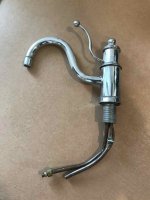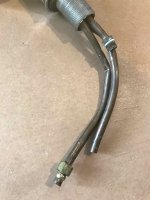SammyClemens
New Member
I got this faucet with an old cast iron sink, and I'd to install it when I switch out my countertops in a few days. My main question is whether someone can tell me just by looking at the pictures whether it's worth the effort, given that one of the lines is crimped. Also the end of the three lines are each different. One looks to be cut. One is threaded. And one seems to be a nut and ferrule. I am making the assumption that the threaded line is for a spray hose (?) which I don't plan on using, so I would need to cap that. Is it possible to repair or replace the other two lines, such that I can connect them to my existing water supply lines with a stainless steel braided hose?
My plumbing experience is limited, as you can probably tell from the description. Any thoughts appreciated!
My plumbing experience is limited, as you can probably tell from the description. Any thoughts appreciated!



